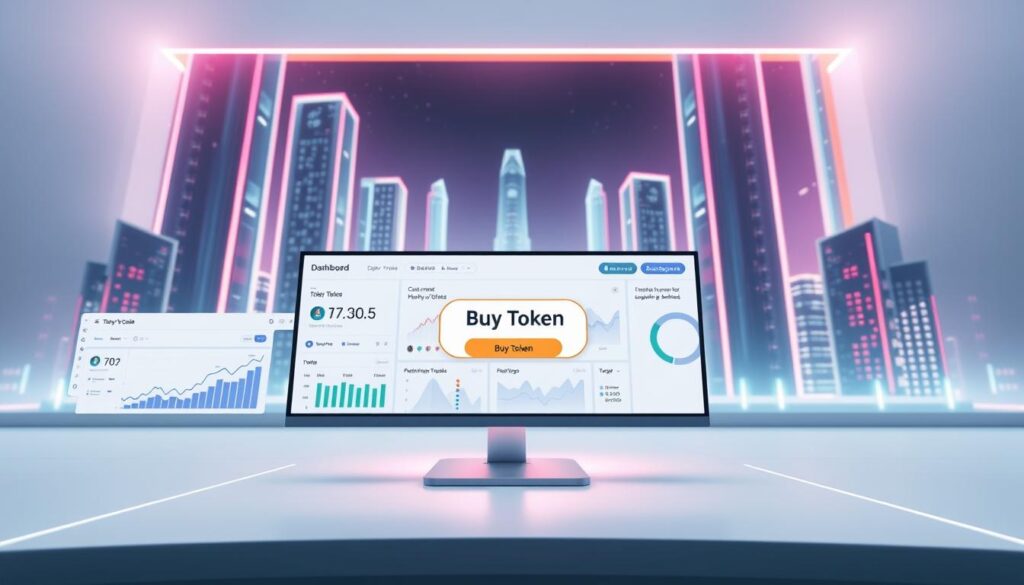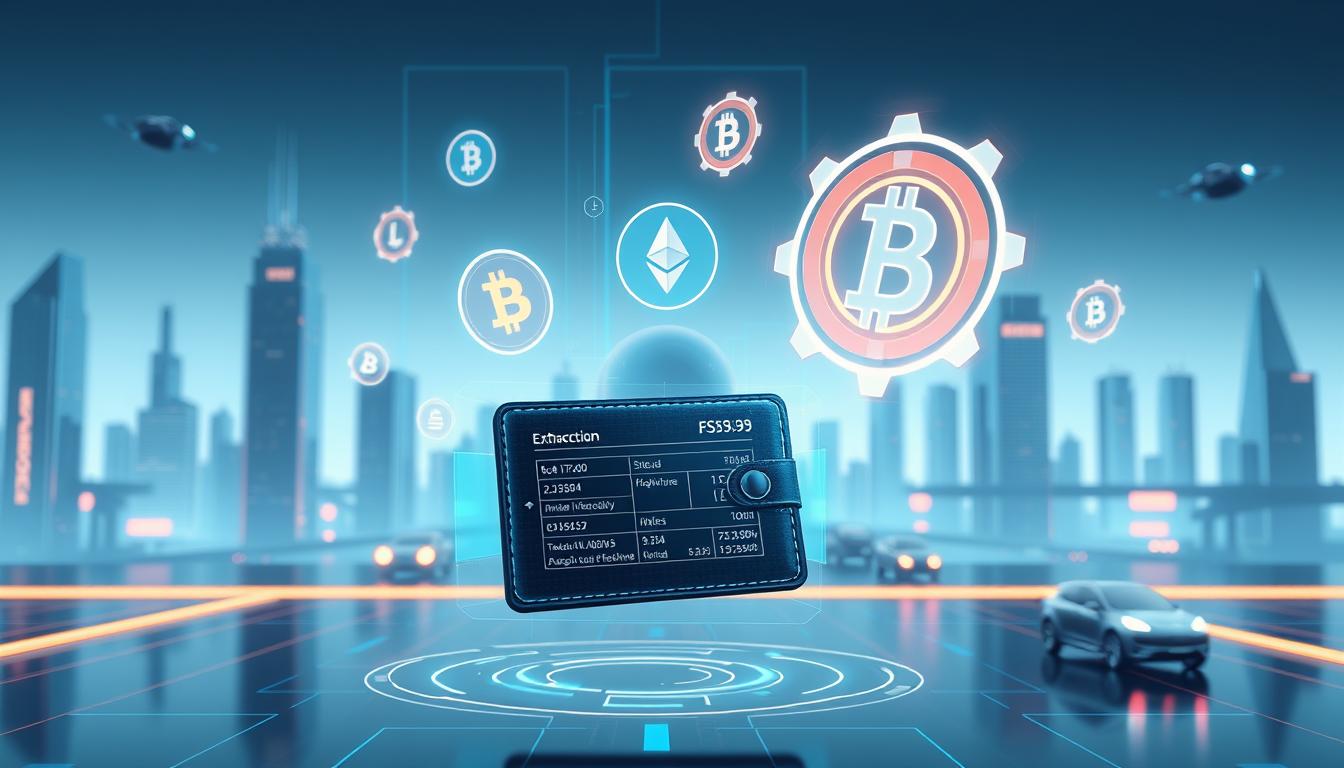Now Reading: Discover the Best NFT Aggregator Multi Marketplace Platform
- 01
Discover the Best NFT Aggregator Multi Marketplace Platform
Discover the Best NFT Aggregator Multi Marketplace Platform

The digital collectibles landscape has evolved dramatically, creating new challenges for traders and collectors. Navigating multiple venues for unique digital assets can be time-consuming and inefficient. This comprehensive guide explores innovative solutions that streamline the entire process.
These advanced tools consolidate listings from various sources into a single, user-friendly interface. They eliminate the need to visit numerous individual sites separately. This approach offers significant time savings and improved efficiency for managing digital collections.
As the sector continues to mature, with revenue projections reaching impressive figures, these consolidated services have become increasingly valuable. They address critical pain points like fragmented liquidity and inconsistent pricing across different venues. Both newcomers and experienced traders will find these tools essential for optimising their trading strategies.
This guide provides detailed information about technical considerations, key features, and strategic benefits. Readers will discover how these services solve common challenges in the digital asset ecosystem.
Key Takeaways
- Consolidated services bring together listings from multiple sources into one interface
- Significant time savings by eliminating the need to visit numerous individual sites
- Improved cost efficiency through optimised transaction fees
- Comprehensive price comparison tools across different trading venues
- Solutions for fragmented liquidity and inconsistent pricing challenges
- Valuable for both new collectors and experienced digital asset traders
- Essential tools as the digital collectibles market continues to mature
Introduction to NFT Aggregator Multi Marketplace Platforms
The journey of digital assets from 2021 to the present day has been a rollercoaster of hype, correction, and maturation. While some predicted a decline, market adjustments have instead paved the way for sustained growth. Revenue is forecast to reach $504.3 million in 2025, demonstrating strong commercial viability.
Esteemed projects like CryptoPunks and Bored Ape Yacht Club continue to rank highly by market capitalisation. Their lasting appeal highlights the enduring value found in premium digital collectibles.
Overview of the NFT Landscape
The expansion of various nft marketplaces has led to a fragmented ecosystem. This makes it difficult for users to efficiently search and compare assets across different platforms.
Advancements in blockchain technology have introduced multi-chain support. This further complicates the landscape, increasing the need for unified tools.
| Challenge for Users | Solution Provided by This Guide |
|---|---|
| Fragmented listings across numerous venues | Understanding tools that consolidate data |
| Difficulty comparing prices and availability | Insight into features for cross-platform analysis |
| Managing transactions on different blockchains | Education on multi-chain compatibility |
Purpose of the Buyer’s Guide
This guide aims to educate potential users and business owners. It provides comprehensive information on services that simplify trading across multiple nft marketplaces.
Readers will learn how to select or develop effective solutions. The goal is to empower informed decisions in this dynamic market.
The Evolution of the NFT Market
Between 2021 and 2025, the digital asset sector experienced remarkable transformations that reshaped collector behaviour. Initial excitement gave way to more sustainable practices as the market matured.
Historical trends and market fluctuations
The digital collectibles journey featured dramatic price swings and shifting collector preferences. Early enthusiasm drove unprecedented trading activity, followed by necessary market corrections.
These fluctuations served as a natural filtering mechanism. Projects with genuine utility and strong communities demonstrated resilience while purely speculative ventures declined.
| Time Period | Market Characteristics | Collector Behaviour |
|---|---|---|
| 2021-2022 | Speculative boom, high volatility | Impulse buying, portfolio diversification |
| 2023-2024 | Market correction, consolidation | Value-focused acquisitions, long-term holding |
| 2025 onwards | Sustainable growth, utility expansion | Strategic collecting, ecosystem participation |
Impact of blockchain technology on NFT growth
Advancements in blockchain technology fundamentally supported digital asset expansion. Improvements in scalability and transaction efficiency made ownership more accessible.
The emergence of layer-2 solutions and alternative networks expanded possibilities beyond initial platforms. This technological progression created both opportunities and fragmentation challenges.
Multi-chain support became standard, allowing creators and collectors to choose networks based on specific needs. These developments made consolidated services essential rather than merely convenient, as highlighted in industry analyses of market infrastructure.
Understanding the NFT Aggregator Marketplace Model
Modern collectors face the challenge of scattered listings across various trading venues, creating inefficiencies in the discovery process. This fragmentation makes finding specific digital assets increasingly difficult as the ecosystem expands.
How aggregators compile listings across platforms
These services function as centralised hubs that gather information from numerous individual sources. They use sophisticated API integrations and blockchain data indexing to pull listing details continuously.
The compilation process ensures real-time synchronisation of pricing, availability, and asset metadata. This technical approach provides comprehensive market coverage without manual searching.
User journey and benefits for collectors
For enthusiasts, the experience is dramatically simplified through a single interface. Instead of maintaining multiple accounts, they access complete market information through one streamlined service.
The model offers significant advantages including time savings and comprehensive price comparison capabilities. Advanced features like portfolio tracking and rarity analysis provide valuable intelligence for informed decisions.
This approach addresses fundamental inefficiencies in the digital asset ecosystem. It reduces friction in discovery and transaction processes, creating a more accessible market for all participants.
Benefits of an NFT Aggregator for Businesses
For enterprises exploring the digital asset sector, building an aggregator service offers a strategic entry point with substantial advantages. This model allows a company to position itself as a central hub rather than just another venue.

The business gains immediate access to a wider audience. It does not need to build its own inventory from scratch.
Expanding market reach and liquidity
An nft aggregator solves a core challenge for any new entrant: fragmented liquidity. By pooling listings from various sources, it creates a deeper, more active market from day one.
This approach significantly expands a company’s reach. It connects buyers and sellers across previously separate platforms.
The revenue potential is diverse and robust. Opportunities include transaction fees, affiliate commissions, and premium subscription services for advanced analytics.
Furthermore, the platform generates invaluable market intelligence. Data on user search patterns and trending collections informs smarter business decisions regarding partnerships and marketing.
This model establishes a powerful network effect. Each new marketplace integration makes the service more valuable, creating a sustainable competitive edge for the business.
Key Features of a Successful NFT Aggregator Platform
Serious collectors demand powerful tools that simplify the complex process of discovering and acquiring digital assets. A well-designed service combines several essential components that work together seamlessly.
Cross-marketplace search and live pricing features
The foundation of any effective service is robust search capability. Users need to query listings across multiple sources using various criteria like collection names or specific traits.
Real-time price tracking is equally crucial. Digital asset values can change dramatically within minutes, making live feeds from multiple sources essential.
Advanced filtering allows refinement by price ranges, rarity scores, and blockchain networks. These features ensure users find exactly what they want at competitive prices.
Portfolio management, analytics and AI tools
Comprehensive portfolio tools transform the experience from simple trading to full asset management. Users can track holdings across different wallets and blockchains.
Sophisticated analytics provide valuable insights through performance charts and trend analysis. Some services incorporate artificial intelligence to predict market movements.
These intelligent features help users make informed decisions based on comprehensive data. The entire ecosystem addresses the complete digital asset lifecycle.
NFT Aggregator Multi Marketplace Platform vs Traditional Marketplaces
Collectors seeking digital assets now face a fundamental choice between two distinct approaches to discovery and acquisition. This comparison examines how these models differ in practical application and user benefits.

Comparison of listings, user journey and pricing options
Traditional trading venues operate as closed ecosystems with significant limitations. They only display items listed directly on their specific platform, creating artificial boundaries within the broader digital assets space.
The aggregator model fundamentally transforms this experience by consolidating listings from numerous sources. This approach provides comprehensive market visibility and access to substantially larger inventories without platform restrictions.
Variety represents another crucial differentiator. These services span multiple blockchain networks and marketplace sources, while traditional options typically limit users to assets within their specific ecosystem.
Price comparison capabilities highlight the superiority of the consolidated approach. Users can conduct real-time cross-platform checks for identical or similar items, while traditional venues provide no visibility into competitor pricing.
The user journey efficiency strongly favours modern solutions. Collectors can conduct comprehensive searches, compare options, and complete purchases through a single interface rather than navigating multiple websites.
Market saturation levels differ significantly between these models. The traditional space has become highly competitive and crowded, while the consolidated segment remains open to innovation and new entrants.
Transaction flexibility on advanced platforms allows purchases from preferred sources while maintaining consistent interface benefits. This combines marketplace competition advantages with user experience simplicity.
A Comprehensive Guide to NFT Aggregator Marketplace Development
Building a consolidated digital asset service requires meticulous planning and a structured development process. This initial phase lays the foundation for a successful and scalable platform.
Thorough preparation helps identify potential hurdles early. It ensures all team members and stakeholders share a clear vision for the project’s goals.
Essential planning and documentation steps
The journey begins with comprehensive stakeholder consultation and requirements gathering. This stage defines the project’s scope, target integrations, and supported blockchain networks.
Creating detailed technical documentation is a critical step in aggregator marketplace development. This includes a development roadmap with clear milestones, timelines, and resource allocation.
User experience research informs the creation of wireframes and prototypes. These maps illustrate user journeys for search, comparison, and transaction activities.
Technical architecture planning establishes the infrastructure. It covers database design, API integration frameworks, and security protocols for protecting user data.
This careful marketplace development phase reduces risks significantly. It addresses challenges like API limitations and scalability constraints before coding begins.
The planning stage also sets up analytics frameworks. These measure performance and user engagement, enabling data-driven optimisation throughout the development lifecycle for your nft aggregator marketplace.
White-Label vs Custom NFT Aggregator Development
Companies entering the digital collectibles space face a crucial development decision between speed and customisation. This choice fundamentally shapes their market entry strategy and long-term competitive positioning.
Advantages and drawbacks of white-label solutions
White-label options provide pre-built software that businesses can rebrand quickly. These solutions typically include core functionality like cross-venue search and basic analytics.
The primary advantage is dramatically reduced time-to-market. Companies can launch in weeks rather than months with lower initial investment.
However, significant limitations include restricted customisation capabilities. Businesses may struggle to differentiate from competitors using identical solutions.
Benefits of bespoke development for scalability
Custom development builds platforms from the ground up with complete control. This approach enables unique features and tailored user experiences.
The bespoke method offers unlimited customisation potential for implementing innovative tools. It provides flexible integration capabilities with emerging venues.
While requiring higher investment and longer timelines, custom development delivers substantially greater competitive differentiation. It supports architectural scalability for long-term growth.
| Factor | White-Label Solution | Custom Development |
|---|---|---|
| Time to Launch | Weeks | Months |
| Initial Investment | £8,000-£40,000 | £40,000-£160,000+ |
| Customisation Level | Limited | Complete |
| Competitive Differentiation | Low | High |
| Long-term Scalability | Provider-dependent | Fully controllable |
The decision between these development paths should consider budget, urgency, and strategic ambitions. Each approach serves different business needs in the evolving digital assets landscape.
Overcoming API and Blockchain Integration Challenges
Technical hurdles in data integration represent a primary obstacle for consolidated digital asset services. Building a robust platform requires seamless connections to numerous external sources and underlying networks.
These services must navigate a complex web of APIs and live blockchain feeds. The goal is to deliver a unified, real-time view of the entire ecosystem.
Handling unreliable API endpoints
APIs from various sources often have limitations. They can be unreliable, provide incomplete information, or restrict request numbers.
Robust systems need sophisticated error handling. This includes fallback sources and automatic retry mechanisms to maintain data flow.
A key strategy involves creating a normalisation layer. This translates diverse API responses into a consistent format for the platform.
Managing network congestion and data accuracy
Network congestion on popular blockchains can slow transactions and increase costs. Services must implement intelligent routing to optimise performance during peak times.
Maintaining accurate, fresh data is critical. Prices can change in seconds, so stale information leads to poor user decisions.
Advanced caching strategies balance speed with freshness. Real-time streaming architectures provide instant updates for price-sensitive information.
| Challenge | Impact on Service | Recommended Solution |
|---|---|---|
| Unreliable API Endpoints | Disrupted data synchronisation | Implement retry logic with fallback sources |
| Network Congestion | Slower transactions, higher fees | Use intelligent routing and timing optimisation |
| Data Accuracy & Freshness | Missed opportunities for users | Deploy real-time streams and tiered caching |
| Regulatory Compliance | Legal and operational risks | Continuous monitoring and KYC/AML procedures |
Optimising Gas Fees and Transaction Processes in NFT Aggregators
The unpredictable nature of network fees creates uncertainty for collectors navigating the digital assets space. These transaction costs can sometimes exceed the value of lower-priced items, making efficient acquisition challenging.

Advanced services address this through sophisticated technical solutions. They transform the economics of digital asset trading.
Smart routing and sidechain utilisation
Intelligent algorithms analyse real-time gas prices across different networks. They automatically select the most cost-effective execution path based on current conditions.
Transaction bundling technology combines multiple purchases into single blockchain transactions. This dramatically reduces per-item gas costs for collectors.
Sidechain utilisation through networks like Polygon provides substantially lower fees. These solutions leverage cost advantages while maintaining seamless user experiences.
Timing optimisation features monitor network congestion patterns. They recommend optimal transaction windows when gas fees historically decline.
These strategies collectively address the gas fee challenge that has limited market accessibility. They enable broader participation through technological innovation.
Seamless Multi-Wallet and Payment Gateway Integration
Wallet compatibility and payment options form the backbone of any successful digital asset trading service. These elements directly impact user accessibility and transaction efficiency across different blockchain environments.
Comprehensive support for popular crypto wallets like MetaMask and Coinbase Wallet ensures immediate familiarity for experienced collectors. The WalletConnect protocol extends this flexibility to mobile solutions through secure QR code authentication.
Hardware wallets from Ledger and Trezor address security-conscious users managing valuable portfolios. This cold storage integration maintains protection while enabling transactions through the service interface.
Built-in custodial options lower barriers for newcomers unfamiliar with self-custody. These should include clear security guidance and migration paths as users gain confidence.
Payment gateway diversification expands market reach significantly. Accepting both crypto payments and traditional payment methods through fiat gateways accommodates diverse user preferences.
This dual approach particularly benefits mainstream participants without existing digital currency holdings. It reduces onboarding friction while maintaining the core advantages of blockchain-based asset trading.
Harnessing AI and In-Depth Analytics for NFT Trading
The most sophisticated services now offer powerful intelligence tools that go far beyond simple listings. These features transform the experience from basic searching into strategic portfolio management.

Real-time market monitoring and predictive insights
Live dashboards provide a constant stream of critical data. Users can monitor trading volumes and price movements as they happen.
This real-time view helps identify emerging trends instantly. It allows for quicker, more informed trading decisions.
Historical analysis tools add crucial context to current market conditions. They show long-term performance patterns for different collections.
Artificial intelligence takes this a step further by generating predictive insights. Algorithms analyse vast datasets to forecast potential price shifts.
Personalised recommendation engines suggest assets based on individual behaviour. This creates a highly tailored experience for each user.
These advanced analytics democratise access to professional-grade intelligence. They level the playing field for all participants.
Leveraging Market Data for Strategic Decisions in Web3
Analytical insights derived from user interactions create powerful competitive advantages for Web3 enterprises. The information gathered through daily operations transforms into valuable intelligence.
Using analytics to shape marketing and partnership strategies
Search behaviour analysis reveals precise demand patterns among your users. This data identifies underserved segments with high interest levels.
Trending collection monitoring provides early signals about emerging projects. This enables proactive partnership development before competitors notice opportunities.
Transaction volume analysis across different sources offers clear competitive intelligence. It shows which features resonate most with different user groups.
Behavioural segmentation allows for highly targeted marketing campaigns. Personalised approaches increase engagement and conversion rates significantly.
Strategic decisions benefit greatly from comprehensive market intelligence. This approach ensures resources target actual user needs rather than assumptions.
Advanced investment tracking tools complement this analytical framework. They provide additional layers of financial insight for complete decision support.
The business value extends beyond immediate user benefits. This strategic information positions companies for long-term success in the evolving digital landscape.
Innovative Trends Shaping the Future of NFT Aggregators
The next generation of consolidated trading tools incorporates groundbreaking features that extend far beyond basic marketplace aggregation. These advancements transform how users interact with digital assets across diverse blockchain environments.
Emerging multi-chain support and technological advancements
Multi-chain compatibility represents a significant evolution in digital asset services. Platforms now integrate with Solana, Polygon, and other emerging networks alongside Ethereum.
This expansion addresses pricing variations for identical collections across different chains. Users gain comprehensive market coverage without switching between multiple interfaces.
Artificial intelligence integration advances beyond simple recommendations. Sophisticated algorithms now handle portfolio rebalancing and fraud detection automatically.
Social trading features allow users to follow successful collector strategies. Gamification elements like achievement systems increase engagement and community interaction.
DeFi integration enables advanced financial strategies including collateralised loans. Metaverse compatibility positions these tools as inventory management systems for virtual worlds.
| Trend | Key Feature | User Benefit |
|---|---|---|
| Multi-Chain Support | Cross-network compatibility | Access to wider inventory and better prices |
| AI Integration | Automated portfolio management | Improved decision-making and risk reduction |
| Social Trading | Strategy mirroring capabilities | Learning from experienced collectors |
| Gamification | Achievement and ranking systems | Increased engagement and community building |
| DeFi Integration | Collateralisation and fractional ownership | Enhanced financial utility for digital assets |
These innovations collectively transform basic aggregation services into comprehensive Web3 ecosystems. They provide central hubs for discovery, trading, and financial management across expanding blockchain networks.
Utilising NFT aggregator multi marketplace platform for Enhanced NFT Trading
The ability to execute complex trading strategies across fragmented markets represents a major advancement for digital asset enthusiasts. These unified services transform how collectors interact with the entire ecosystem.
Streamlining purchases and comparison across diverse marketplaces
A quality nft aggregator marketplace provides immediate access to countless digital items. Users can search across all connected venues simultaneously.
The power to compare prices for identical assets prevents overpaying. This transparency creates fairer conditions for all participants in the trading process.
Bulk purchasing capabilities represent another significant advantage. Acquiring multiple nfts from different marketplaces in one transaction saves considerable time and resources.
This aggregator marketplace model essentially creates a supercharged browsing experience. The marketplace aggregator approach eliminates traditional limitations of single-venue shopping.
Conclusion
Digital asset trading has reached a pivotal moment where consolidated services are no longer optional but essential infrastructure. This guide has explored how these solutions address market fragmentation while providing strategic advantages for both collectors and enterprises.
The decision to develop or utilise such a service represents a significant opportunity for any business entering the Web3 space. Choosing between white-label and custom approaches requires careful consideration of objectives and resources.
Partnering with an experienced development company like SCAND or Blockchain App Factory ensures your platform development meets current needs while allowing for future growth. Their specialised development services combine technical expertise with practical market understanding.
As the sector continues evolving, these consolidated tools will shape how digital assets are discovered and traded. Now is the ideal time to leverage professional services that create lasting competitive advantages in this dynamic landscape.
FAQ
What is the main purpose of an NFT aggregator?
These services compile digital asset listings from various sources into a single interface. This allows collectors to browse, compare prices, and make purchases without visiting multiple sites individually, saving considerable time and effort.
How do these platforms help reduce transaction costs?
They often employ smart routing technology to optimise gas fees. By bundling purchases or selecting less congested networks, they can significantly lower the expenses associated with blockchain transactions for the user.
What security measures are typically in place for users?
Reputable services integrate securely with non-custodial crypto wallets, meaning users retain control of their private keys. Transactions are executed through audited smart contracts, and robust data encryption protects personal information.
Can I manage my entire collection through an aggregator?
Yes, many top-tier platforms offer comprehensive portfolio management tools. These features allow you to track the value of your holdings across different marketplaces, view historical performance, and access detailed analytics.
What are the advantages for businesses using this model?
Companies can tap into a wider audience and increased liquidity by listing their assets across multiple venues simultaneously. This expanded reach often leads to faster sales and better price discovery for digital collectibles.
How does the user experience differ from a traditional marketplace?
The journey is more streamlined. Instead of checking several sites, users get a unified view of available items. Advanced filters, live pricing data, and side-by-side comparison tools make finding the best deal much simpler.
What should I consider when choosing a development company?
Look for a provider with proven expertise in blockchain technology and smart contracts. Assess their experience with API integrations, their approach to handling network congestion, and their ability to deliver a scalable, user-friendly application.
Are white-label solutions a good option for launching quickly?
White-label options can accelerate your time to market, offering a pre-built foundation. However, custom development provides greater flexibility for unique features, branding, and long-term growth, which may be more beneficial for strategic goals.














